Unit 4: Management and Operations Report - Debenhams Company Analysis
VerifiedAdded on 2022/12/27
|12
|3983
|43
Report
AI Summary
This report provides a comprehensive analysis of management and operations within the context of the Debenhams company. It begins by defining and comparing the roles and characteristics of leaders and managers, highlighting their distinct responsibilities in guiding and motivating teams, setting objectives, and resolving conflicts. The report then examines practical examples of how leadership and management functions apply in various situational contexts, such as introducing new products and engaging employees. It further applies leadership theories, including situational leadership, system theory, and contingency theory, to the Debenhams case study. The analysis extends to key approaches in operations management, such as operational management, lean production, and just-in-time inventory, emphasizing the roles of leaders and managers in these processes. The report assesses factors within the business environment that impact operational management and decision-making, culminating in an understanding of how these elements contribute to achieving business objectives. The report underscores the importance of effective management in achieving growth and profitability, providing insights into the strategies and practices employed by Debenhams to optimize its operations and leadership.
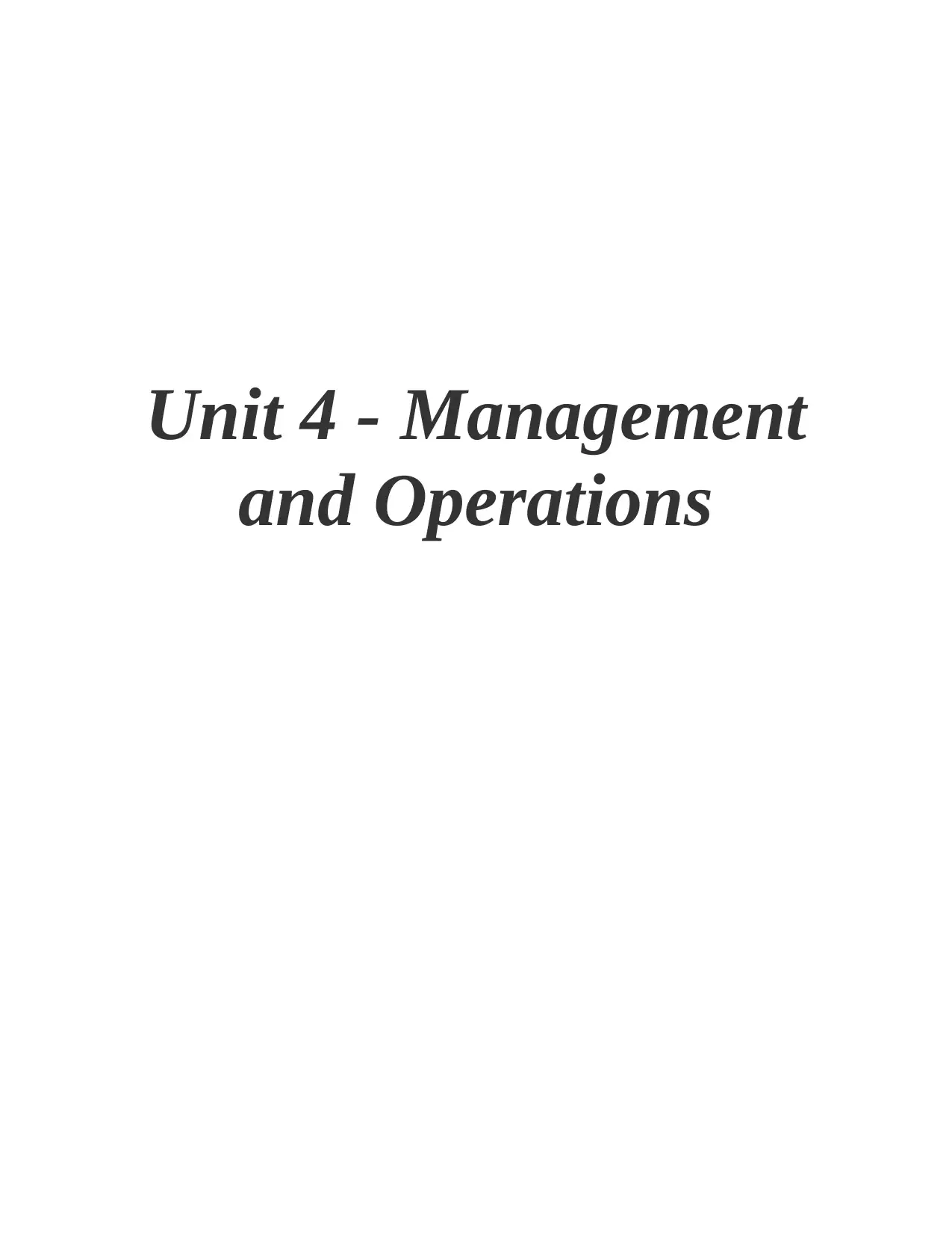
Unit 4 - Management
and Operations
and Operations
Paraphrase This Document
Need a fresh take? Get an instant paraphrase of this document with our AI Paraphraser

Table of Contents
INTRODUCTION ..........................................................................................................................3
MAIN BODY...................................................................................................................................3
TASK-1............................................................................................................................................3
P1 Define and compare the different roles and characteristics of a leader and a manager.........3
TASK-2 ...........................................................................................................................................5
P2 Examine examples of how the role of a leader and the function of a manager apply in
different situational contexts.......................................................................................................5
P3. Apply different theories and models ....................................................................................6
TASK-3............................................................................................................................................7
P4 Explain the key approaches to operations management and the role that leaders and
managers play..............................................................................................................................7
P5 Explain the importance and value of operations management in achieving business
objectives.....................................................................................................................................8
TASK-4 ...........................................................................................................................................9
P6 Assess the factors within the business environment that impact upon operational
management and decision-making by leaders and managers.....................................................9
CONCLUSION .............................................................................................................................11
REFERENCES..............................................................................................................................12
INTRODUCTION ..........................................................................................................................3
MAIN BODY...................................................................................................................................3
TASK-1............................................................................................................................................3
P1 Define and compare the different roles and characteristics of a leader and a manager.........3
TASK-2 ...........................................................................................................................................5
P2 Examine examples of how the role of a leader and the function of a manager apply in
different situational contexts.......................................................................................................5
P3. Apply different theories and models ....................................................................................6
TASK-3............................................................................................................................................7
P4 Explain the key approaches to operations management and the role that leaders and
managers play..............................................................................................................................7
P5 Explain the importance and value of operations management in achieving business
objectives.....................................................................................................................................8
TASK-4 ...........................................................................................................................................9
P6 Assess the factors within the business environment that impact upon operational
management and decision-making by leaders and managers.....................................................9
CONCLUSION .............................................................................................................................11
REFERENCES..............................................................................................................................12
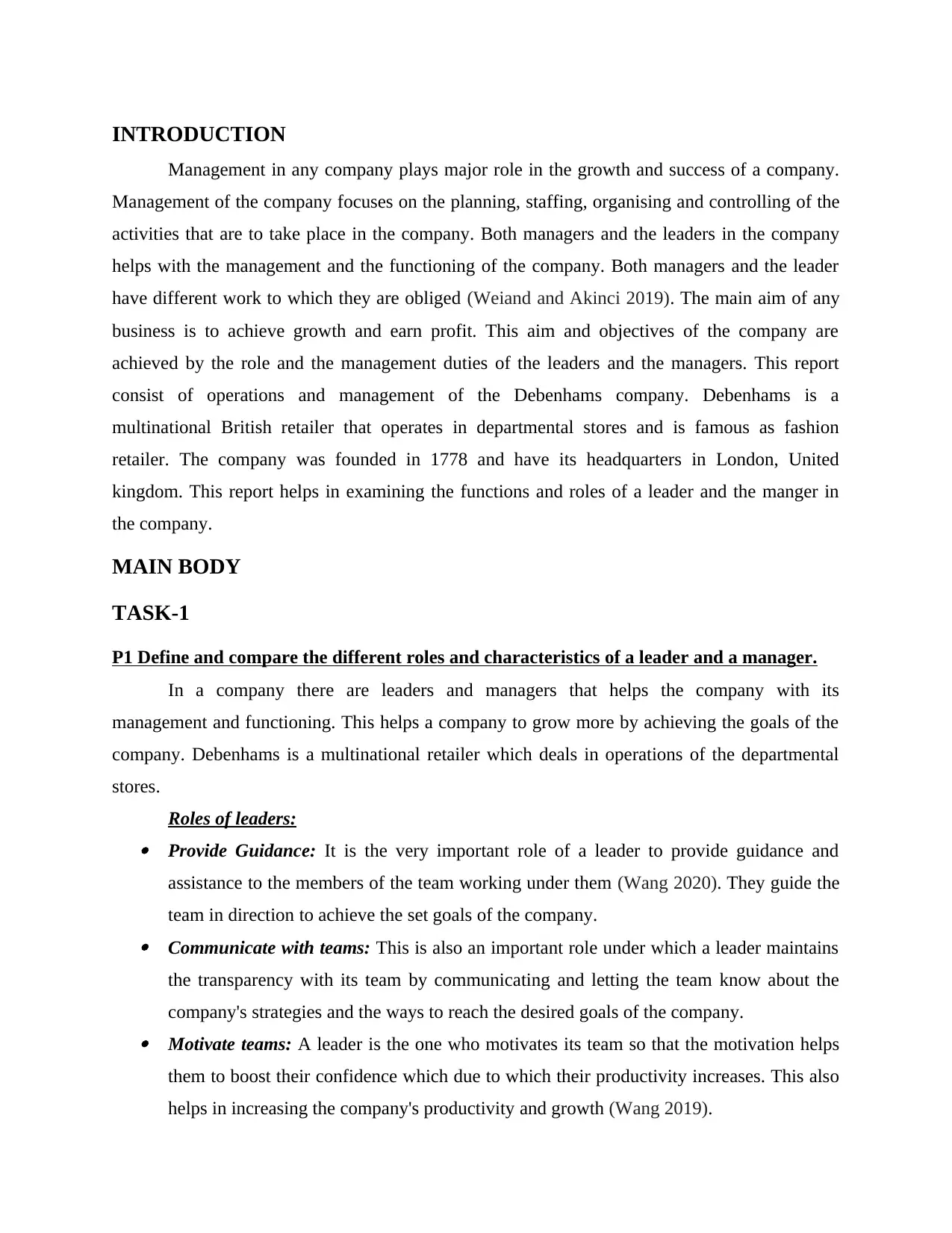
INTRODUCTION
Management in any company plays major role in the growth and success of a company.
Management of the company focuses on the planning, staffing, organising and controlling of the
activities that are to take place in the company. Both managers and the leaders in the company
helps with the management and the functioning of the company. Both managers and the leader
have different work to which they are obliged (Weiand and Akinci 2019). The main aim of any
business is to achieve growth and earn profit. This aim and objectives of the company are
achieved by the role and the management duties of the leaders and the managers. This report
consist of operations and management of the Debenhams company. Debenhams is a
multinational British retailer that operates in departmental stores and is famous as fashion
retailer. The company was founded in 1778 and have its headquarters in London, United
kingdom. This report helps in examining the functions and roles of a leader and the manger in
the company.
MAIN BODY
TASK-1
P1 Define and compare the different roles and characteristics of a leader and a manager.
In a company there are leaders and managers that helps the company with its
management and functioning. This helps a company to grow more by achieving the goals of the
company. Debenhams is a multinational retailer which deals in operations of the departmental
stores.
Roles of leaders: Provide Guidance: It is the very important role of a leader to provide guidance and
assistance to the members of the team working under them (Wang 2020). They guide the
team in direction to achieve the set goals of the company. Communicate with teams: This is also an important role under which a leader maintains
the transparency with its team by communicating and letting the team know about the
company's strategies and the ways to reach the desired goals of the company. Motivate teams: A leader is the one who motivates its team so that the motivation helps
them to boost their confidence which due to which their productivity increases. This also
helps in increasing the company's productivity and growth (Wang 2019).
Management in any company plays major role in the growth and success of a company.
Management of the company focuses on the planning, staffing, organising and controlling of the
activities that are to take place in the company. Both managers and the leaders in the company
helps with the management and the functioning of the company. Both managers and the leader
have different work to which they are obliged (Weiand and Akinci 2019). The main aim of any
business is to achieve growth and earn profit. This aim and objectives of the company are
achieved by the role and the management duties of the leaders and the managers. This report
consist of operations and management of the Debenhams company. Debenhams is a
multinational British retailer that operates in departmental stores and is famous as fashion
retailer. The company was founded in 1778 and have its headquarters in London, United
kingdom. This report helps in examining the functions and roles of a leader and the manger in
the company.
MAIN BODY
TASK-1
P1 Define and compare the different roles and characteristics of a leader and a manager.
In a company there are leaders and managers that helps the company with its
management and functioning. This helps a company to grow more by achieving the goals of the
company. Debenhams is a multinational retailer which deals in operations of the departmental
stores.
Roles of leaders: Provide Guidance: It is the very important role of a leader to provide guidance and
assistance to the members of the team working under them (Wang 2020). They guide the
team in direction to achieve the set goals of the company. Communicate with teams: This is also an important role under which a leader maintains
the transparency with its team by communicating and letting the team know about the
company's strategies and the ways to reach the desired goals of the company. Motivate teams: A leader is the one who motivates its team so that the motivation helps
them to boost their confidence which due to which their productivity increases. This also
helps in increasing the company's productivity and growth (Wang 2019).
⊘ This is a preview!⊘
Do you want full access?
Subscribe today to unlock all pages.

Trusted by 1+ million students worldwide
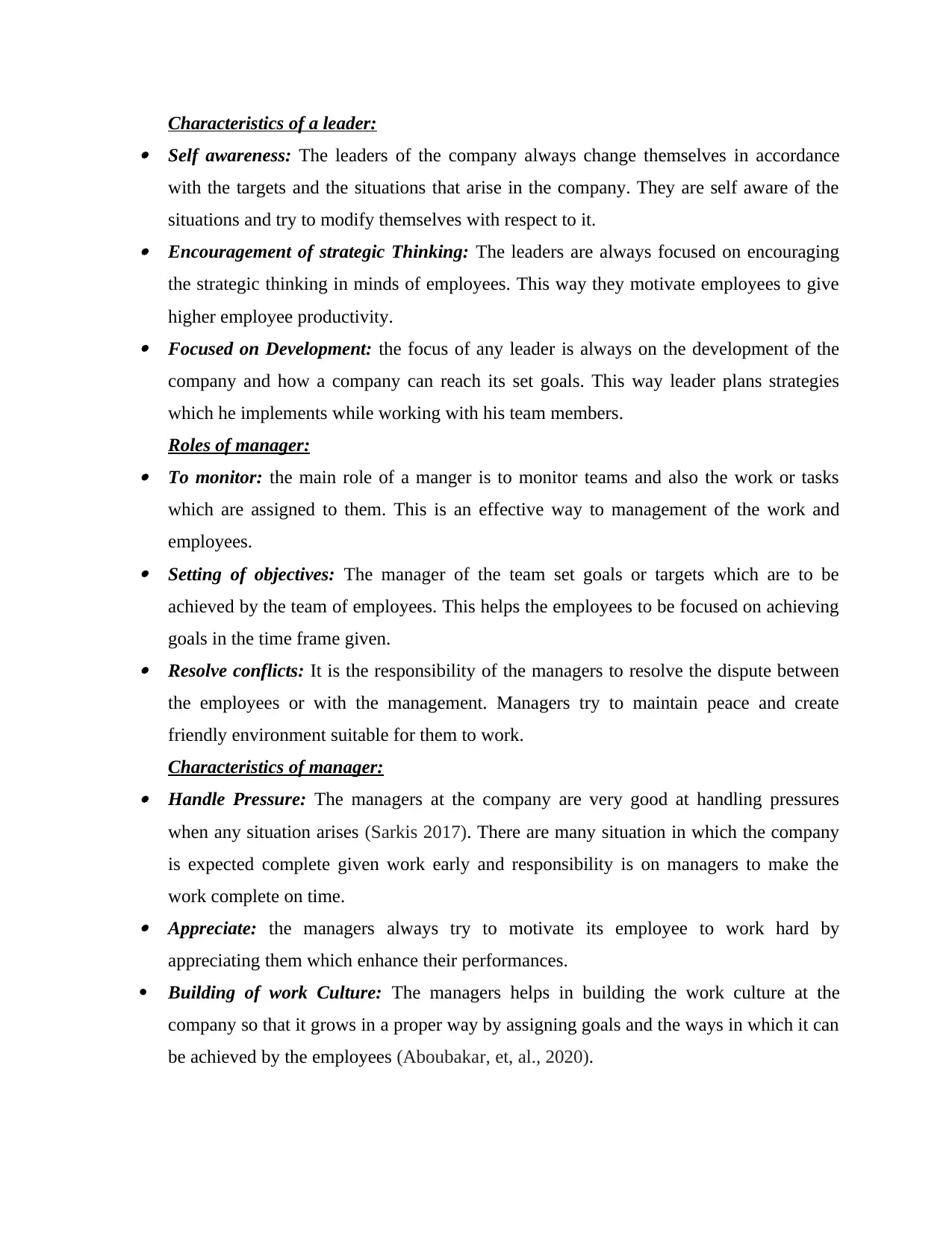
Characteristics of a leader: Self awareness: The leaders of the company always change themselves in accordance
with the targets and the situations that arise in the company. They are self aware of the
situations and try to modify themselves with respect to it. Encouragement of strategic Thinking: The leaders are always focused on encouraging
the strategic thinking in minds of employees. This way they motivate employees to give
higher employee productivity. Focused on Development: the focus of any leader is always on the development of the
company and how a company can reach its set goals. This way leader plans strategies
which he implements while working with his team members.
Roles of manager: To monitor: the main role of a manger is to monitor teams and also the work or tasks
which are assigned to them. This is an effective way to management of the work and
employees. Setting of objectives: The manager of the team set goals or targets which are to be
achieved by the team of employees. This helps the employees to be focused on achieving
goals in the time frame given. Resolve conflicts: It is the responsibility of the managers to resolve the dispute between
the employees or with the management. Managers try to maintain peace and create
friendly environment suitable for them to work.
Characteristics of manager: Handle Pressure: The managers at the company are very good at handling pressures
when any situation arises (Sarkis 2017). There are many situation in which the company
is expected complete given work early and responsibility is on managers to make the
work complete on time. Appreciate: the managers always try to motivate its employee to work hard by
appreciating them which enhance their performances.
Building of work Culture: The managers helps in building the work culture at the
company so that it grows in a proper way by assigning goals and the ways in which it can
be achieved by the employees (Aboubakar, et, al., 2020).
with the targets and the situations that arise in the company. They are self aware of the
situations and try to modify themselves with respect to it. Encouragement of strategic Thinking: The leaders are always focused on encouraging
the strategic thinking in minds of employees. This way they motivate employees to give
higher employee productivity. Focused on Development: the focus of any leader is always on the development of the
company and how a company can reach its set goals. This way leader plans strategies
which he implements while working with his team members.
Roles of manager: To monitor: the main role of a manger is to monitor teams and also the work or tasks
which are assigned to them. This is an effective way to management of the work and
employees. Setting of objectives: The manager of the team set goals or targets which are to be
achieved by the team of employees. This helps the employees to be focused on achieving
goals in the time frame given. Resolve conflicts: It is the responsibility of the managers to resolve the dispute between
the employees or with the management. Managers try to maintain peace and create
friendly environment suitable for them to work.
Characteristics of manager: Handle Pressure: The managers at the company are very good at handling pressures
when any situation arises (Sarkis 2017). There are many situation in which the company
is expected complete given work early and responsibility is on managers to make the
work complete on time. Appreciate: the managers always try to motivate its employee to work hard by
appreciating them which enhance their performances.
Building of work Culture: The managers helps in building the work culture at the
company so that it grows in a proper way by assigning goals and the ways in which it can
be achieved by the employees (Aboubakar, et, al., 2020).
Paraphrase This Document
Need a fresh take? Get an instant paraphrase of this document with our AI Paraphraser
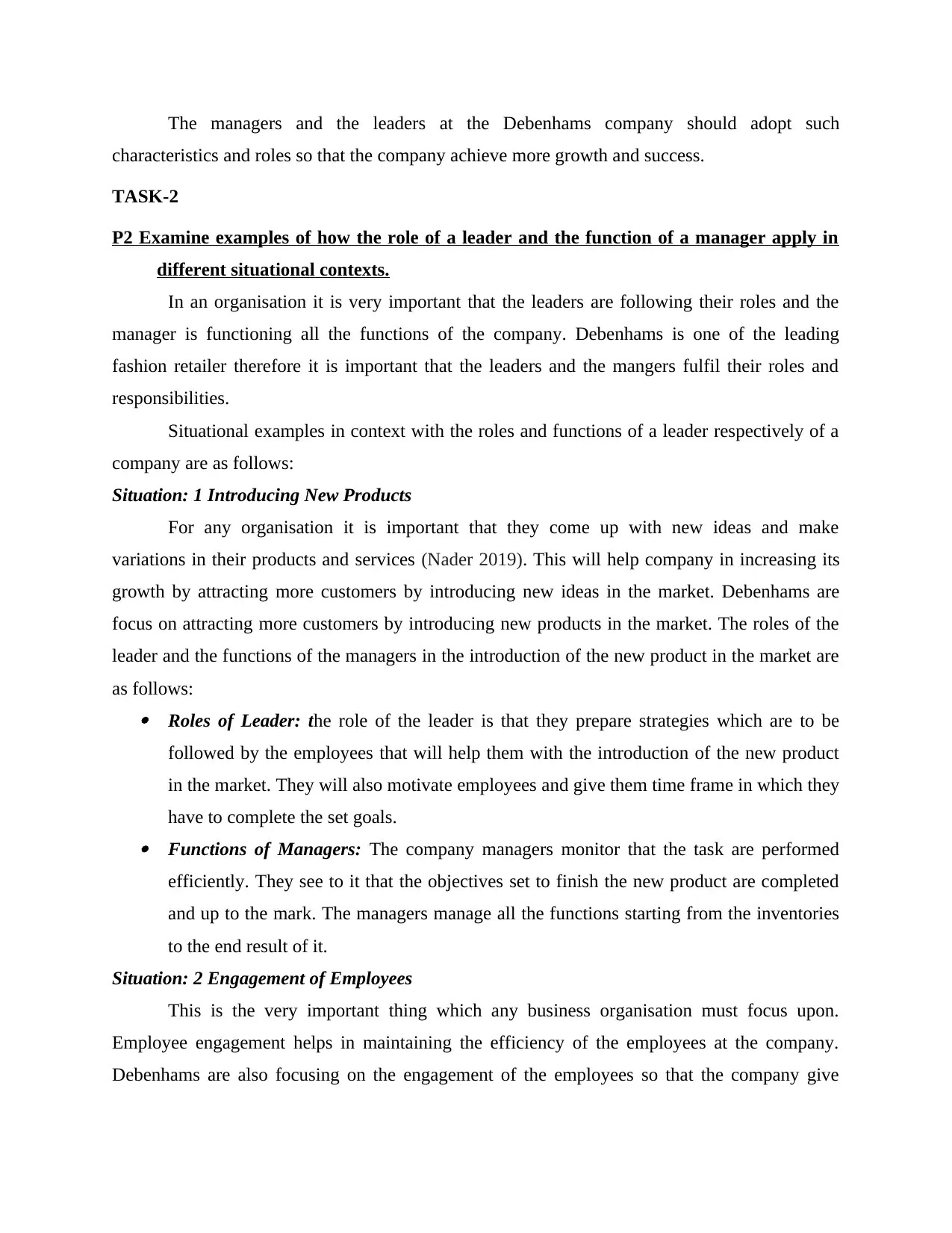
The managers and the leaders at the Debenhams company should adopt such
characteristics and roles so that the company achieve more growth and success.
TASK-2
P2 Examine examples of how the role of a leader and the function of a manager apply in
different situational contexts.
In an organisation it is very important that the leaders are following their roles and the
manager is functioning all the functions of the company. Debenhams is one of the leading
fashion retailer therefore it is important that the leaders and the mangers fulfil their roles and
responsibilities.
Situational examples in context with the roles and functions of a leader respectively of a
company are as follows:
Situation: 1 Introducing New Products
For any organisation it is important that they come up with new ideas and make
variations in their products and services (Nader 2019). This will help company in increasing its
growth by attracting more customers by introducing new ideas in the market. Debenhams are
focus on attracting more customers by introducing new products in the market. The roles of the
leader and the functions of the managers in the introduction of the new product in the market are
as follows: Roles of Leader: the role of the leader is that they prepare strategies which are to be
followed by the employees that will help them with the introduction of the new product
in the market. They will also motivate employees and give them time frame in which they
have to complete the set goals. Functions of Managers: The company managers monitor that the task are performed
efficiently. They see to it that the objectives set to finish the new product are completed
and up to the mark. The managers manage all the functions starting from the inventories
to the end result of it.
Situation: 2 Engagement of Employees
This is the very important thing which any business organisation must focus upon.
Employee engagement helps in maintaining the efficiency of the employees at the company.
Debenhams are also focusing on the engagement of the employees so that the company give
characteristics and roles so that the company achieve more growth and success.
TASK-2
P2 Examine examples of how the role of a leader and the function of a manager apply in
different situational contexts.
In an organisation it is very important that the leaders are following their roles and the
manager is functioning all the functions of the company. Debenhams is one of the leading
fashion retailer therefore it is important that the leaders and the mangers fulfil their roles and
responsibilities.
Situational examples in context with the roles and functions of a leader respectively of a
company are as follows:
Situation: 1 Introducing New Products
For any organisation it is important that they come up with new ideas and make
variations in their products and services (Nader 2019). This will help company in increasing its
growth by attracting more customers by introducing new ideas in the market. Debenhams are
focus on attracting more customers by introducing new products in the market. The roles of the
leader and the functions of the managers in the introduction of the new product in the market are
as follows: Roles of Leader: the role of the leader is that they prepare strategies which are to be
followed by the employees that will help them with the introduction of the new product
in the market. They will also motivate employees and give them time frame in which they
have to complete the set goals. Functions of Managers: The company managers monitor that the task are performed
efficiently. They see to it that the objectives set to finish the new product are completed
and up to the mark. The managers manage all the functions starting from the inventories
to the end result of it.
Situation: 2 Engagement of Employees
This is the very important thing which any business organisation must focus upon.
Employee engagement helps in maintaining the efficiency of the employees at the company.
Debenhams are also focusing on the engagement of the employees so that the company give
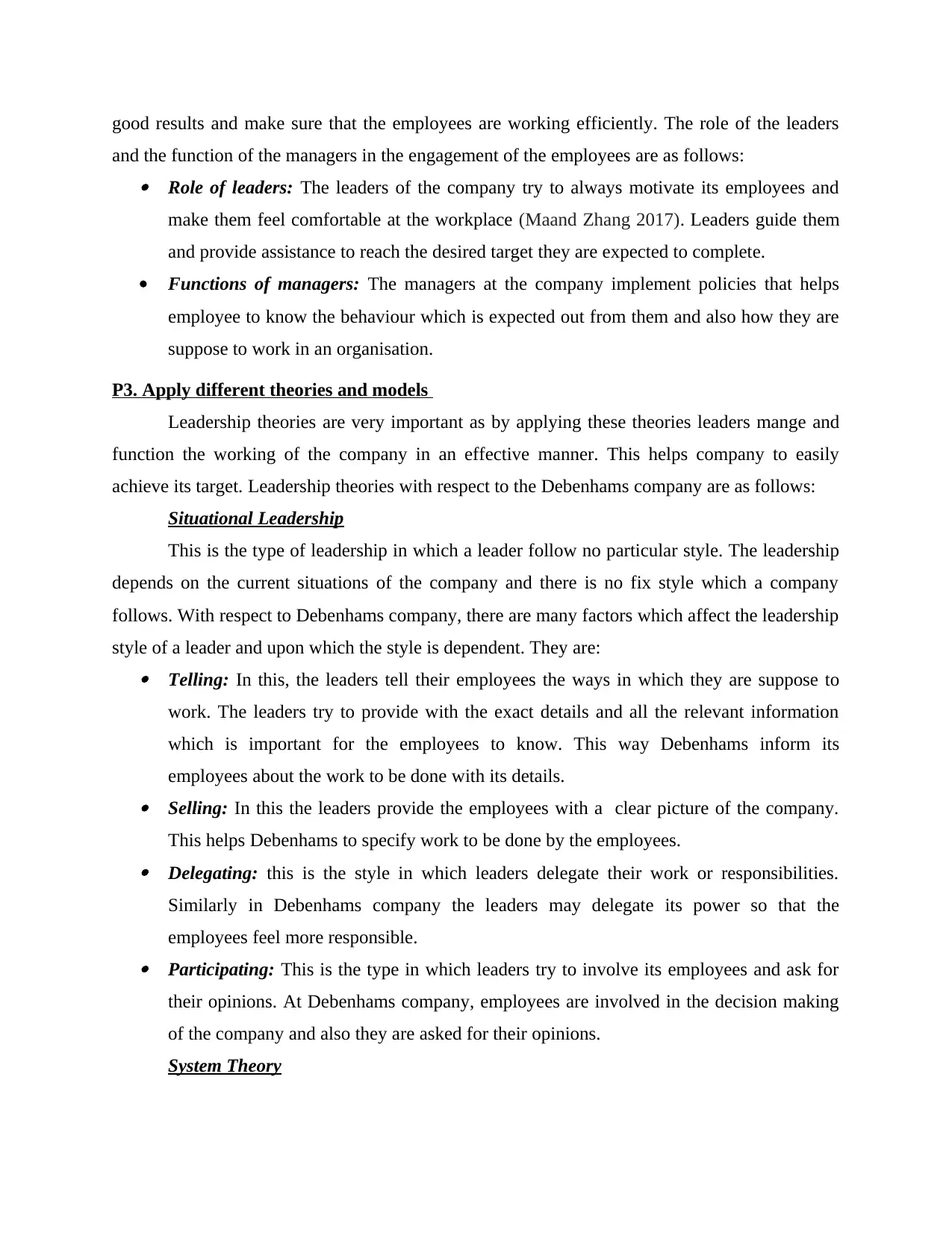
good results and make sure that the employees are working efficiently. The role of the leaders
and the function of the managers in the engagement of the employees are as follows: Role of leaders: The leaders of the company try to always motivate its employees and
make them feel comfortable at the workplace (Maand Zhang 2017). Leaders guide them
and provide assistance to reach the desired target they are expected to complete.
Functions of managers: The managers at the company implement policies that helps
employee to know the behaviour which is expected out from them and also how they are
suppose to work in an organisation.
P3. Apply different theories and models
Leadership theories are very important as by applying these theories leaders mange and
function the working of the company in an effective manner. This helps company to easily
achieve its target. Leadership theories with respect to the Debenhams company are as follows:
Situational Leadership
This is the type of leadership in which a leader follow no particular style. The leadership
depends on the current situations of the company and there is no fix style which a company
follows. With respect to Debenhams company, there are many factors which affect the leadership
style of a leader and upon which the style is dependent. They are: Telling: In this, the leaders tell their employees the ways in which they are suppose to
work. The leaders try to provide with the exact details and all the relevant information
which is important for the employees to know. This way Debenhams inform its
employees about the work to be done with its details. Selling: In this the leaders provide the employees with a clear picture of the company.
This helps Debenhams to specify work to be done by the employees. Delegating: this is the style in which leaders delegate their work or responsibilities.
Similarly in Debenhams company the leaders may delegate its power so that the
employees feel more responsible. Participating: This is the type in which leaders try to involve its employees and ask for
their opinions. At Debenhams company, employees are involved in the decision making
of the company and also they are asked for their opinions.
System Theory
and the function of the managers in the engagement of the employees are as follows: Role of leaders: The leaders of the company try to always motivate its employees and
make them feel comfortable at the workplace (Maand Zhang 2017). Leaders guide them
and provide assistance to reach the desired target they are expected to complete.
Functions of managers: The managers at the company implement policies that helps
employee to know the behaviour which is expected out from them and also how they are
suppose to work in an organisation.
P3. Apply different theories and models
Leadership theories are very important as by applying these theories leaders mange and
function the working of the company in an effective manner. This helps company to easily
achieve its target. Leadership theories with respect to the Debenhams company are as follows:
Situational Leadership
This is the type of leadership in which a leader follow no particular style. The leadership
depends on the current situations of the company and there is no fix style which a company
follows. With respect to Debenhams company, there are many factors which affect the leadership
style of a leader and upon which the style is dependent. They are: Telling: In this, the leaders tell their employees the ways in which they are suppose to
work. The leaders try to provide with the exact details and all the relevant information
which is important for the employees to know. This way Debenhams inform its
employees about the work to be done with its details. Selling: In this the leaders provide the employees with a clear picture of the company.
This helps Debenhams to specify work to be done by the employees. Delegating: this is the style in which leaders delegate their work or responsibilities.
Similarly in Debenhams company the leaders may delegate its power so that the
employees feel more responsible. Participating: This is the type in which leaders try to involve its employees and ask for
their opinions. At Debenhams company, employees are involved in the decision making
of the company and also they are asked for their opinions.
System Theory
⊘ This is a preview!⊘
Do you want full access?
Subscribe today to unlock all pages.

Trusted by 1+ million students worldwide
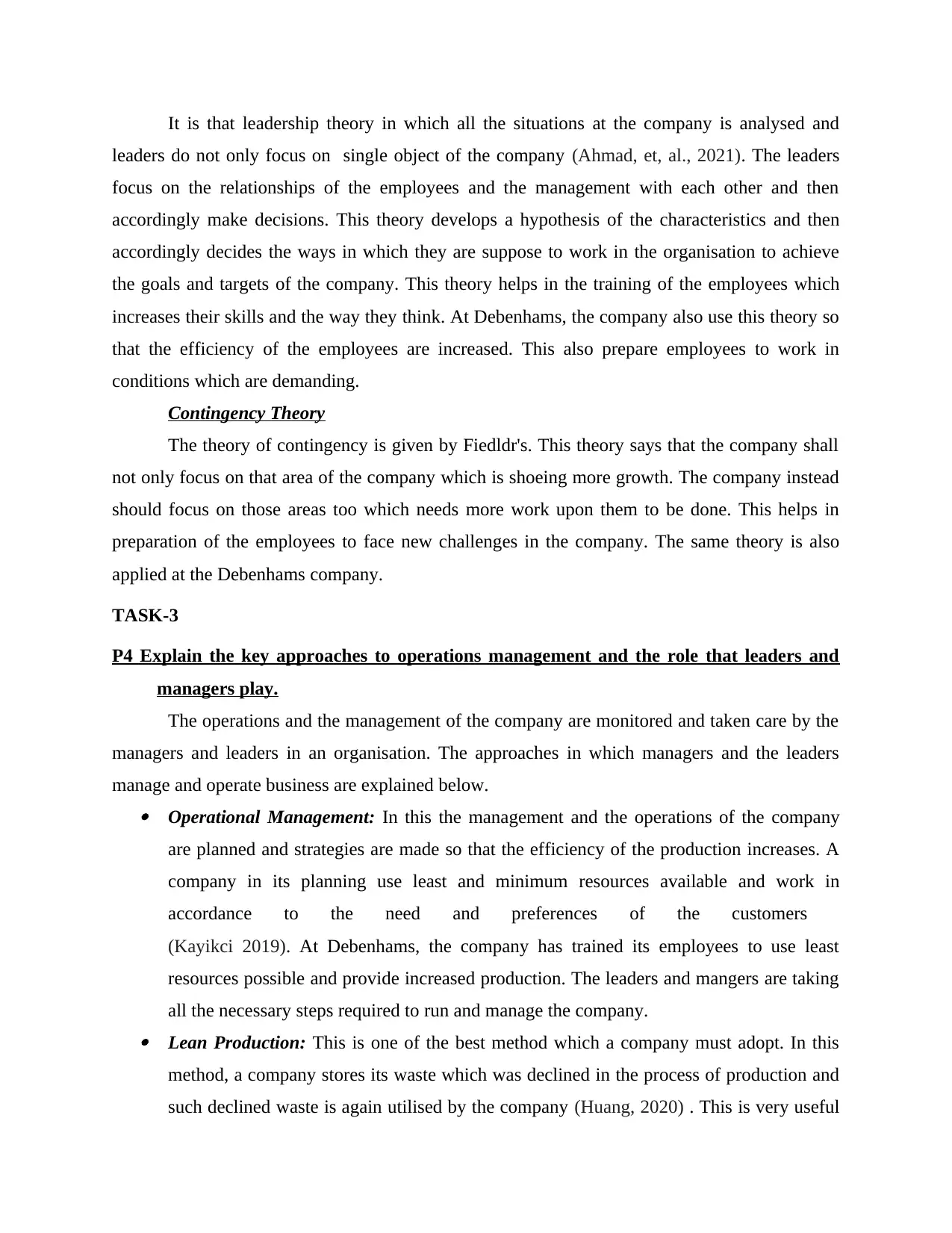
It is that leadership theory in which all the situations at the company is analysed and
leaders do not only focus on single object of the company (Ahmad, et, al., 2021). The leaders
focus on the relationships of the employees and the management with each other and then
accordingly make decisions. This theory develops a hypothesis of the characteristics and then
accordingly decides the ways in which they are suppose to work in the organisation to achieve
the goals and targets of the company. This theory helps in the training of the employees which
increases their skills and the way they think. At Debenhams, the company also use this theory so
that the efficiency of the employees are increased. This also prepare employees to work in
conditions which are demanding.
Contingency Theory
The theory of contingency is given by Fiedldr's. This theory says that the company shall
not only focus on that area of the company which is shoeing more growth. The company instead
should focus on those areas too which needs more work upon them to be done. This helps in
preparation of the employees to face new challenges in the company. The same theory is also
applied at the Debenhams company.
TASK-3
P4 Explain the key approaches to operations management and the role that leaders and
managers play.
The operations and the management of the company are monitored and taken care by the
managers and leaders in an organisation. The approaches in which managers and the leaders
manage and operate business are explained below. Operational Management: In this the management and the operations of the company
are planned and strategies are made so that the efficiency of the production increases. A
company in its planning use least and minimum resources available and work in
accordance to the need and preferences of the customers
(Kayikci 2019). At Debenhams, the company has trained its employees to use least
resources possible and provide increased production. The leaders and mangers are taking
all the necessary steps required to run and manage the company. Lean Production: This is one of the best method which a company must adopt. In this
method, a company stores its waste which was declined in the process of production and
such declined waste is again utilised by the company (Huang, 2020) . This is very useful
leaders do not only focus on single object of the company (Ahmad, et, al., 2021). The leaders
focus on the relationships of the employees and the management with each other and then
accordingly make decisions. This theory develops a hypothesis of the characteristics and then
accordingly decides the ways in which they are suppose to work in the organisation to achieve
the goals and targets of the company. This theory helps in the training of the employees which
increases their skills and the way they think. At Debenhams, the company also use this theory so
that the efficiency of the employees are increased. This also prepare employees to work in
conditions which are demanding.
Contingency Theory
The theory of contingency is given by Fiedldr's. This theory says that the company shall
not only focus on that area of the company which is shoeing more growth. The company instead
should focus on those areas too which needs more work upon them to be done. This helps in
preparation of the employees to face new challenges in the company. The same theory is also
applied at the Debenhams company.
TASK-3
P4 Explain the key approaches to operations management and the role that leaders and
managers play.
The operations and the management of the company are monitored and taken care by the
managers and leaders in an organisation. The approaches in which managers and the leaders
manage and operate business are explained below. Operational Management: In this the management and the operations of the company
are planned and strategies are made so that the efficiency of the production increases. A
company in its planning use least and minimum resources available and work in
accordance to the need and preferences of the customers
(Kayikci 2019). At Debenhams, the company has trained its employees to use least
resources possible and provide increased production. The leaders and mangers are taking
all the necessary steps required to run and manage the company. Lean Production: This is one of the best method which a company must adopt. In this
method, a company stores its waste which was declined in the process of production and
such declined waste is again utilised by the company (Huang, 2020) . This is very useful
Paraphrase This Document
Need a fresh take? Get an instant paraphrase of this document with our AI Paraphraser
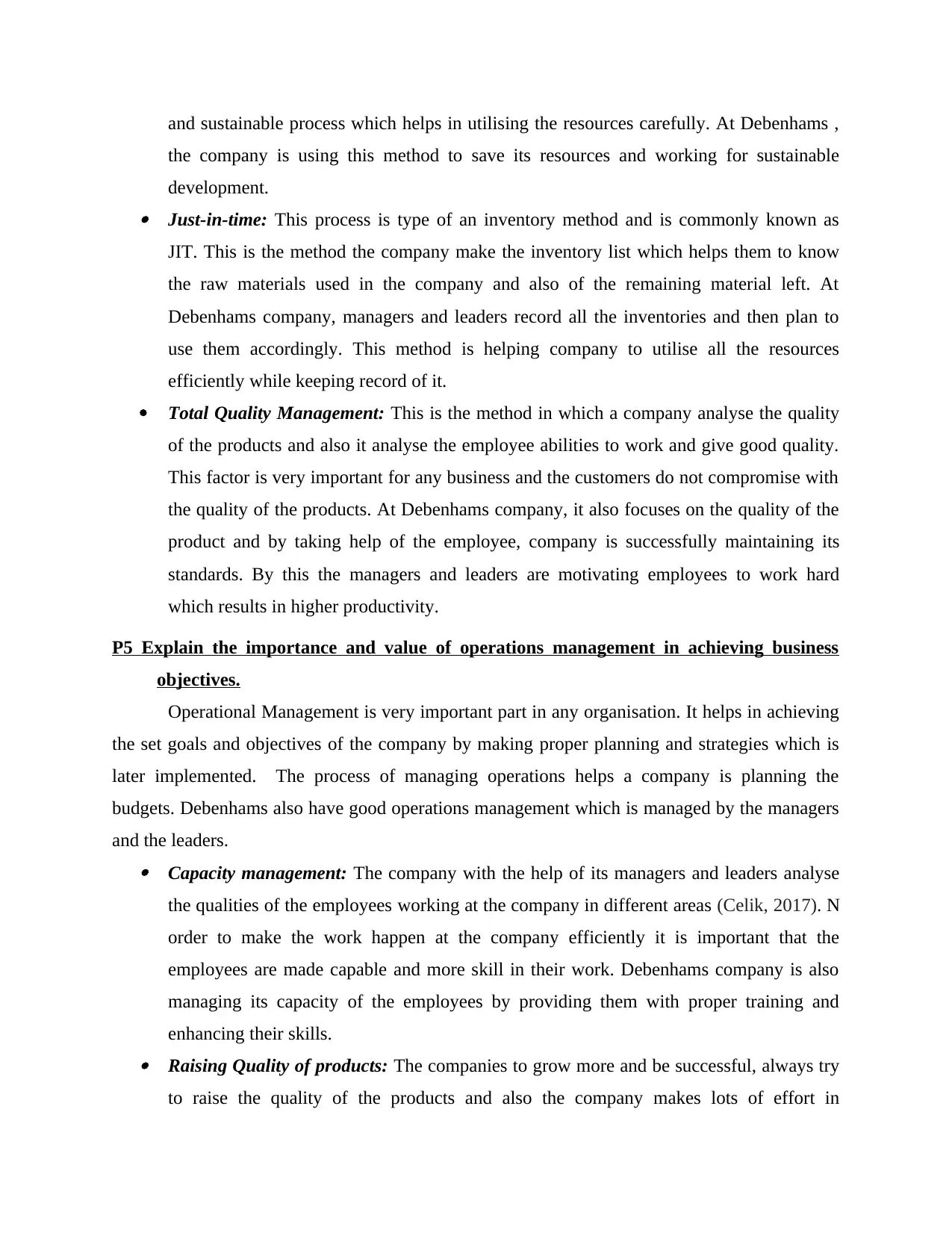
and sustainable process which helps in utilising the resources carefully. At Debenhams ,
the company is using this method to save its resources and working for sustainable
development. Just-in-time: This process is type of an inventory method and is commonly known as
JIT. This is the method the company make the inventory list which helps them to know
the raw materials used in the company and also of the remaining material left. At
Debenhams company, managers and leaders record all the inventories and then plan to
use them accordingly. This method is helping company to utilise all the resources
efficiently while keeping record of it.
Total Quality Management: This is the method in which a company analyse the quality
of the products and also it analyse the employee abilities to work and give good quality.
This factor is very important for any business and the customers do not compromise with
the quality of the products. At Debenhams company, it also focuses on the quality of the
product and by taking help of the employee, company is successfully maintaining its
standards. By this the managers and leaders are motivating employees to work hard
which results in higher productivity.
P5 Explain the importance and value of operations management in achieving business
objectives.
Operational Management is very important part in any organisation. It helps in achieving
the set goals and objectives of the company by making proper planning and strategies which is
later implemented. The process of managing operations helps a company is planning the
budgets. Debenhams also have good operations management which is managed by the managers
and the leaders. Capacity management: The company with the help of its managers and leaders analyse
the qualities of the employees working at the company in different areas (Celik, 2017). N
order to make the work happen at the company efficiently it is important that the
employees are made capable and more skill in their work. Debenhams company is also
managing its capacity of the employees by providing them with proper training and
enhancing their skills. Raising Quality of products: The companies to grow more and be successful, always try
to raise the quality of the products and also the company makes lots of effort in
the company is using this method to save its resources and working for sustainable
development. Just-in-time: This process is type of an inventory method and is commonly known as
JIT. This is the method the company make the inventory list which helps them to know
the raw materials used in the company and also of the remaining material left. At
Debenhams company, managers and leaders record all the inventories and then plan to
use them accordingly. This method is helping company to utilise all the resources
efficiently while keeping record of it.
Total Quality Management: This is the method in which a company analyse the quality
of the products and also it analyse the employee abilities to work and give good quality.
This factor is very important for any business and the customers do not compromise with
the quality of the products. At Debenhams company, it also focuses on the quality of the
product and by taking help of the employee, company is successfully maintaining its
standards. By this the managers and leaders are motivating employees to work hard
which results in higher productivity.
P5 Explain the importance and value of operations management in achieving business
objectives.
Operational Management is very important part in any organisation. It helps in achieving
the set goals and objectives of the company by making proper planning and strategies which is
later implemented. The process of managing operations helps a company is planning the
budgets. Debenhams also have good operations management which is managed by the managers
and the leaders. Capacity management: The company with the help of its managers and leaders analyse
the qualities of the employees working at the company in different areas (Celik, 2017). N
order to make the work happen at the company efficiently it is important that the
employees are made capable and more skill in their work. Debenhams company is also
managing its capacity of the employees by providing them with proper training and
enhancing their skills. Raising Quality of products: The companies to grow more and be successful, always try
to raise the quality of the products and also the company makes lots of effort in
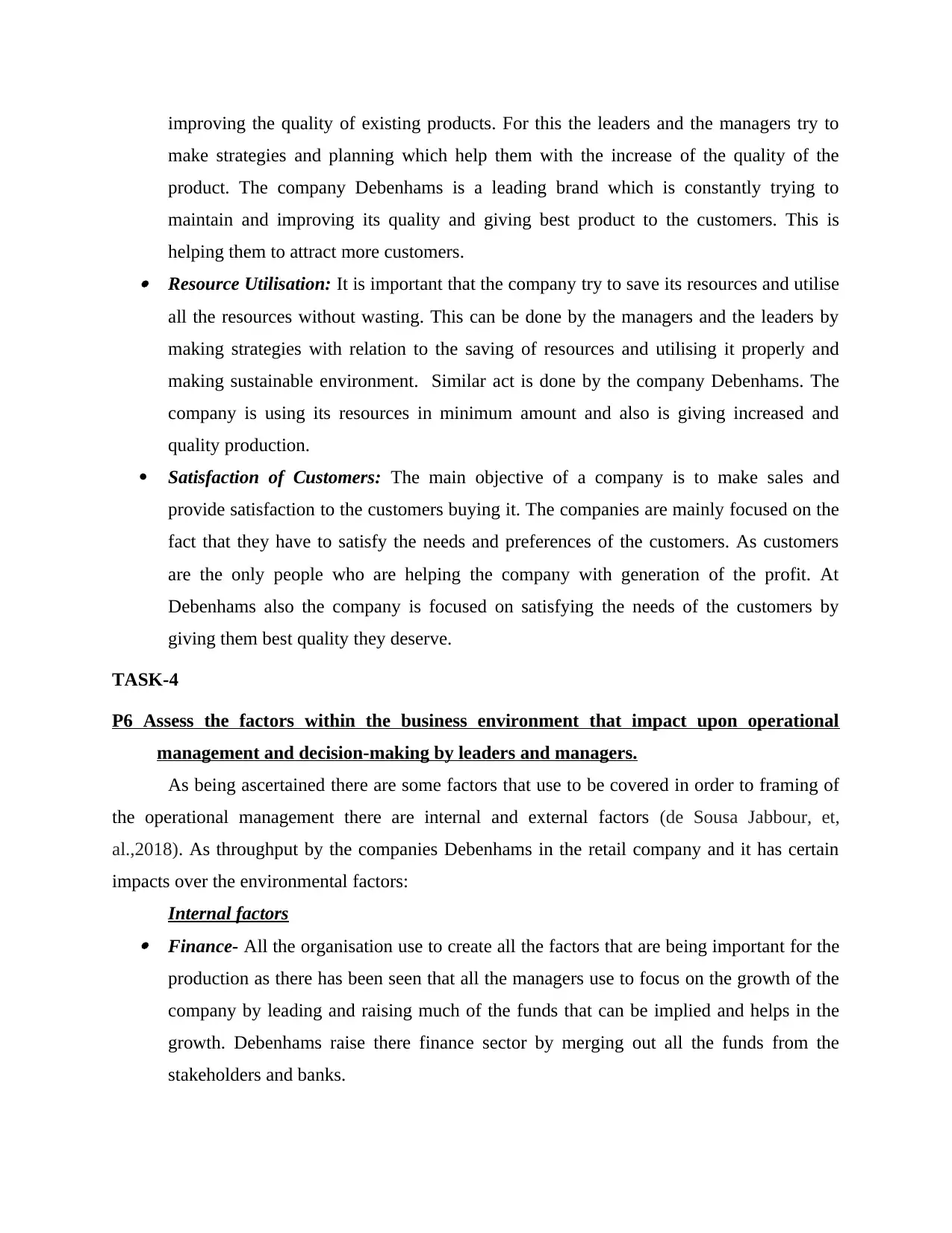
improving the quality of existing products. For this the leaders and the managers try to
make strategies and planning which help them with the increase of the quality of the
product. The company Debenhams is a leading brand which is constantly trying to
maintain and improving its quality and giving best product to the customers. This is
helping them to attract more customers. Resource Utilisation: It is important that the company try to save its resources and utilise
all the resources without wasting. This can be done by the managers and the leaders by
making strategies with relation to the saving of resources and utilising it properly and
making sustainable environment. Similar act is done by the company Debenhams. The
company is using its resources in minimum amount and also is giving increased and
quality production.
Satisfaction of Customers: The main objective of a company is to make sales and
provide satisfaction to the customers buying it. The companies are mainly focused on the
fact that they have to satisfy the needs and preferences of the customers. As customers
are the only people who are helping the company with generation of the profit. At
Debenhams also the company is focused on satisfying the needs of the customers by
giving them best quality they deserve.
TASK-4
P6 Assess the factors within the business environment that impact upon operational
management and decision-making by leaders and managers.
As being ascertained there are some factors that use to be covered in order to framing of
the operational management there are internal and external factors (de Sousa Jabbour, et,
al.,2018). As throughput by the companies Debenhams in the retail company and it has certain
impacts over the environmental factors:
Internal factors Finance- All the organisation use to create all the factors that are being important for the
production as there has been seen that all the managers use to focus on the growth of the
company by leading and raising much of the funds that can be implied and helps in the
growth. Debenhams raise there finance sector by merging out all the funds from the
stakeholders and banks.
make strategies and planning which help them with the increase of the quality of the
product. The company Debenhams is a leading brand which is constantly trying to
maintain and improving its quality and giving best product to the customers. This is
helping them to attract more customers. Resource Utilisation: It is important that the company try to save its resources and utilise
all the resources without wasting. This can be done by the managers and the leaders by
making strategies with relation to the saving of resources and utilising it properly and
making sustainable environment. Similar act is done by the company Debenhams. The
company is using its resources in minimum amount and also is giving increased and
quality production.
Satisfaction of Customers: The main objective of a company is to make sales and
provide satisfaction to the customers buying it. The companies are mainly focused on the
fact that they have to satisfy the needs and preferences of the customers. As customers
are the only people who are helping the company with generation of the profit. At
Debenhams also the company is focused on satisfying the needs of the customers by
giving them best quality they deserve.
TASK-4
P6 Assess the factors within the business environment that impact upon operational
management and decision-making by leaders and managers.
As being ascertained there are some factors that use to be covered in order to framing of
the operational management there are internal and external factors (de Sousa Jabbour, et,
al.,2018). As throughput by the companies Debenhams in the retail company and it has certain
impacts over the environmental factors:
Internal factors Finance- All the organisation use to create all the factors that are being important for the
production as there has been seen that all the managers use to focus on the growth of the
company by leading and raising much of the funds that can be implied and helps in the
growth. Debenhams raise there finance sector by merging out all the funds from the
stakeholders and banks.
⊘ This is a preview!⊘
Do you want full access?
Subscribe today to unlock all pages.

Trusted by 1+ million students worldwide
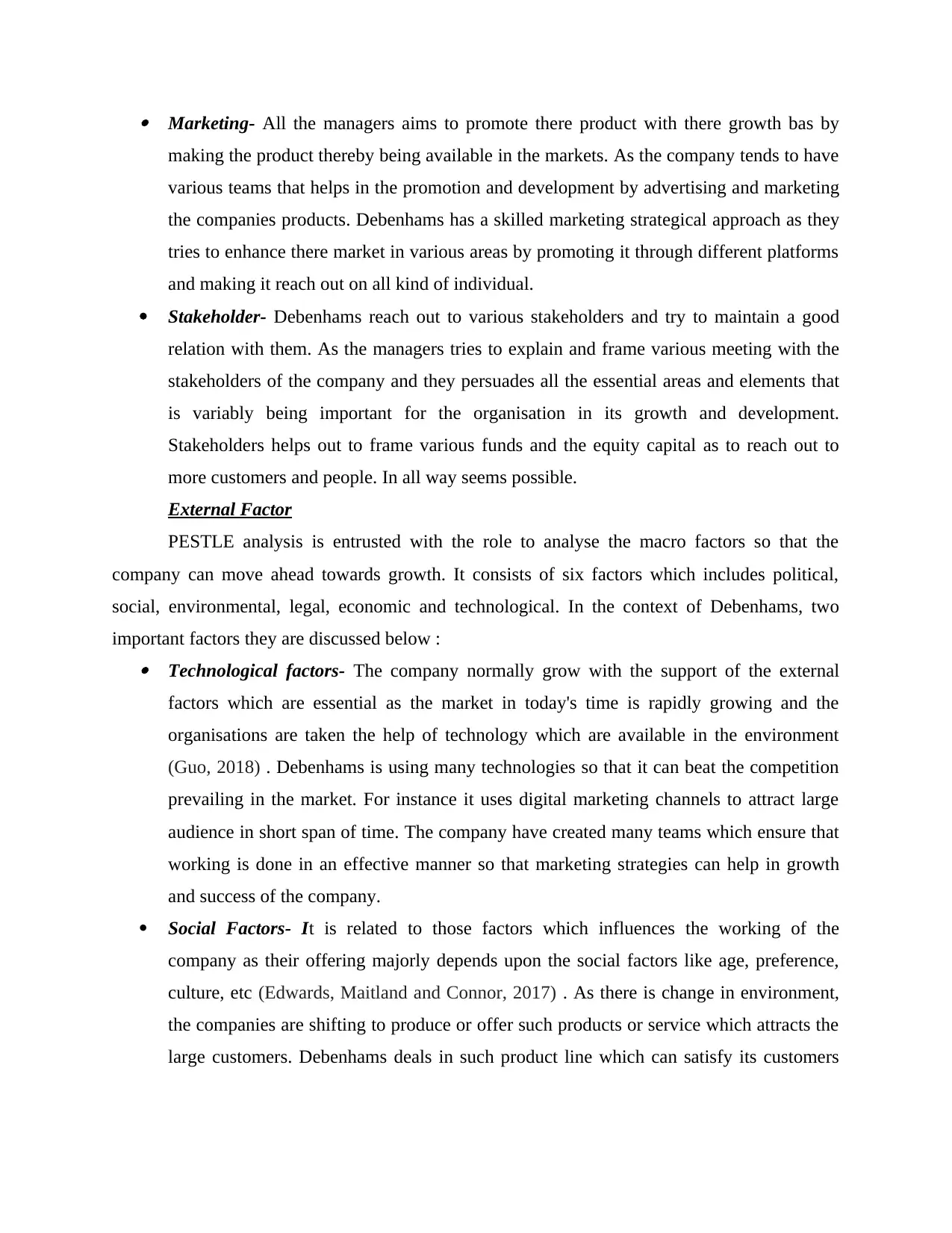
Marketing- All the managers aims to promote there product with there growth bas by
making the product thereby being available in the markets. As the company tends to have
various teams that helps in the promotion and development by advertising and marketing
the companies products. Debenhams has a skilled marketing strategical approach as they
tries to enhance there market in various areas by promoting it through different platforms
and making it reach out on all kind of individual.
Stakeholder- Debenhams reach out to various stakeholders and try to maintain a good
relation with them. As the managers tries to explain and frame various meeting with the
stakeholders of the company and they persuades all the essential areas and elements that
is variably being important for the organisation in its growth and development.
Stakeholders helps out to frame various funds and the equity capital as to reach out to
more customers and people. In all way seems possible.
External Factor
PESTLE analysis is entrusted with the role to analyse the macro factors so that the
company can move ahead towards growth. It consists of six factors which includes political,
social, environmental, legal, economic and technological. In the context of Debenhams, two
important factors they are discussed below : Technological factors- The company normally grow with the support of the external
factors which are essential as the market in today's time is rapidly growing and the
organisations are taken the help of technology which are available in the environment
(Guo, 2018) . Debenhams is using many technologies so that it can beat the competition
prevailing in the market. For instance it uses digital marketing channels to attract large
audience in short span of time. The company have created many teams which ensure that
working is done in an effective manner so that marketing strategies can help in growth
and success of the company.
Social Factors- It is related to those factors which influences the working of the
company as their offering majorly depends upon the social factors like age, preference,
culture, etc (Edwards, Maitland and Connor, 2017) . As there is change in environment,
the companies are shifting to produce or offer such products or service which attracts the
large customers. Debenhams deals in such product line which can satisfy its customers
making the product thereby being available in the markets. As the company tends to have
various teams that helps in the promotion and development by advertising and marketing
the companies products. Debenhams has a skilled marketing strategical approach as they
tries to enhance there market in various areas by promoting it through different platforms
and making it reach out on all kind of individual.
Stakeholder- Debenhams reach out to various stakeholders and try to maintain a good
relation with them. As the managers tries to explain and frame various meeting with the
stakeholders of the company and they persuades all the essential areas and elements that
is variably being important for the organisation in its growth and development.
Stakeholders helps out to frame various funds and the equity capital as to reach out to
more customers and people. In all way seems possible.
External Factor
PESTLE analysis is entrusted with the role to analyse the macro factors so that the
company can move ahead towards growth. It consists of six factors which includes political,
social, environmental, legal, economic and technological. In the context of Debenhams, two
important factors they are discussed below : Technological factors- The company normally grow with the support of the external
factors which are essential as the market in today's time is rapidly growing and the
organisations are taken the help of technology which are available in the environment
(Guo, 2018) . Debenhams is using many technologies so that it can beat the competition
prevailing in the market. For instance it uses digital marketing channels to attract large
audience in short span of time. The company have created many teams which ensure that
working is done in an effective manner so that marketing strategies can help in growth
and success of the company.
Social Factors- It is related to those factors which influences the working of the
company as their offering majorly depends upon the social factors like age, preference,
culture, etc (Edwards, Maitland and Connor, 2017) . As there is change in environment,
the companies are shifting to produce or offer such products or service which attracts the
large customers. Debenhams deals in such product line which can satisfy its customers
Paraphrase This Document
Need a fresh take? Get an instant paraphrase of this document with our AI Paraphraser
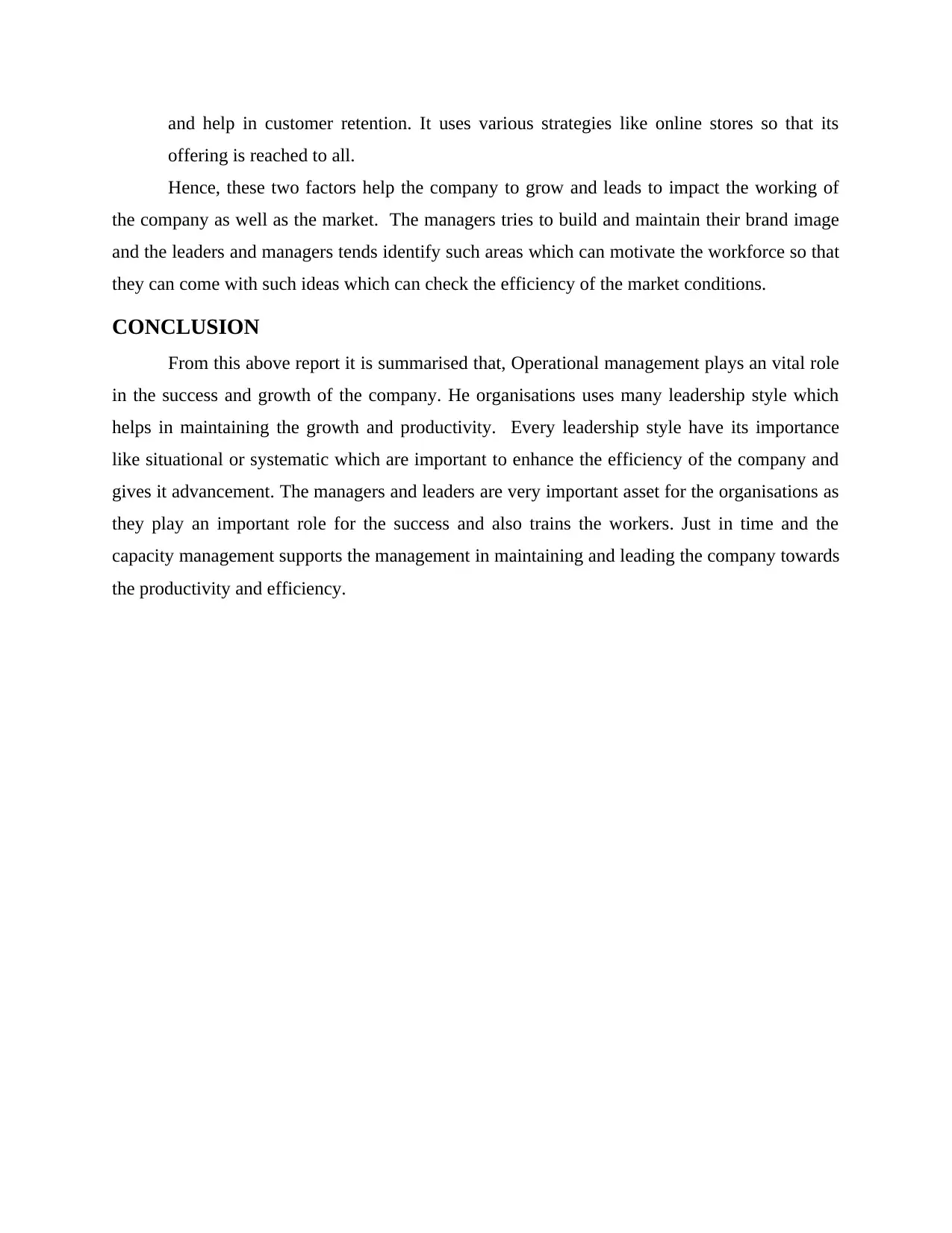
and help in customer retention. It uses various strategies like online stores so that its
offering is reached to all.
Hence, these two factors help the company to grow and leads to impact the working of
the company as well as the market. The managers tries to build and maintain their brand image
and the leaders and managers tends identify such areas which can motivate the workforce so that
they can come with such ideas which can check the efficiency of the market conditions.
CONCLUSION
From this above report it is summarised that, Operational management plays an vital role
in the success and growth of the company. He organisations uses many leadership style which
helps in maintaining the growth and productivity. Every leadership style have its importance
like situational or systematic which are important to enhance the efficiency of the company and
gives it advancement. The managers and leaders are very important asset for the organisations as
they play an important role for the success and also trains the workers. Just in time and the
capacity management supports the management in maintaining and leading the company towards
the productivity and efficiency.
offering is reached to all.
Hence, these two factors help the company to grow and leads to impact the working of
the company as well as the market. The managers tries to build and maintain their brand image
and the leaders and managers tends identify such areas which can motivate the workforce so that
they can come with such ideas which can check the efficiency of the market conditions.
CONCLUSION
From this above report it is summarised that, Operational management plays an vital role
in the success and growth of the company. He organisations uses many leadership style which
helps in maintaining the growth and productivity. Every leadership style have its importance
like situational or systematic which are important to enhance the efficiency of the company and
gives it advancement. The managers and leaders are very important asset for the organisations as
they play an important role for the success and also trains the workers. Just in time and the
capacity management supports the management in maintaining and leading the company towards
the productivity and efficiency.
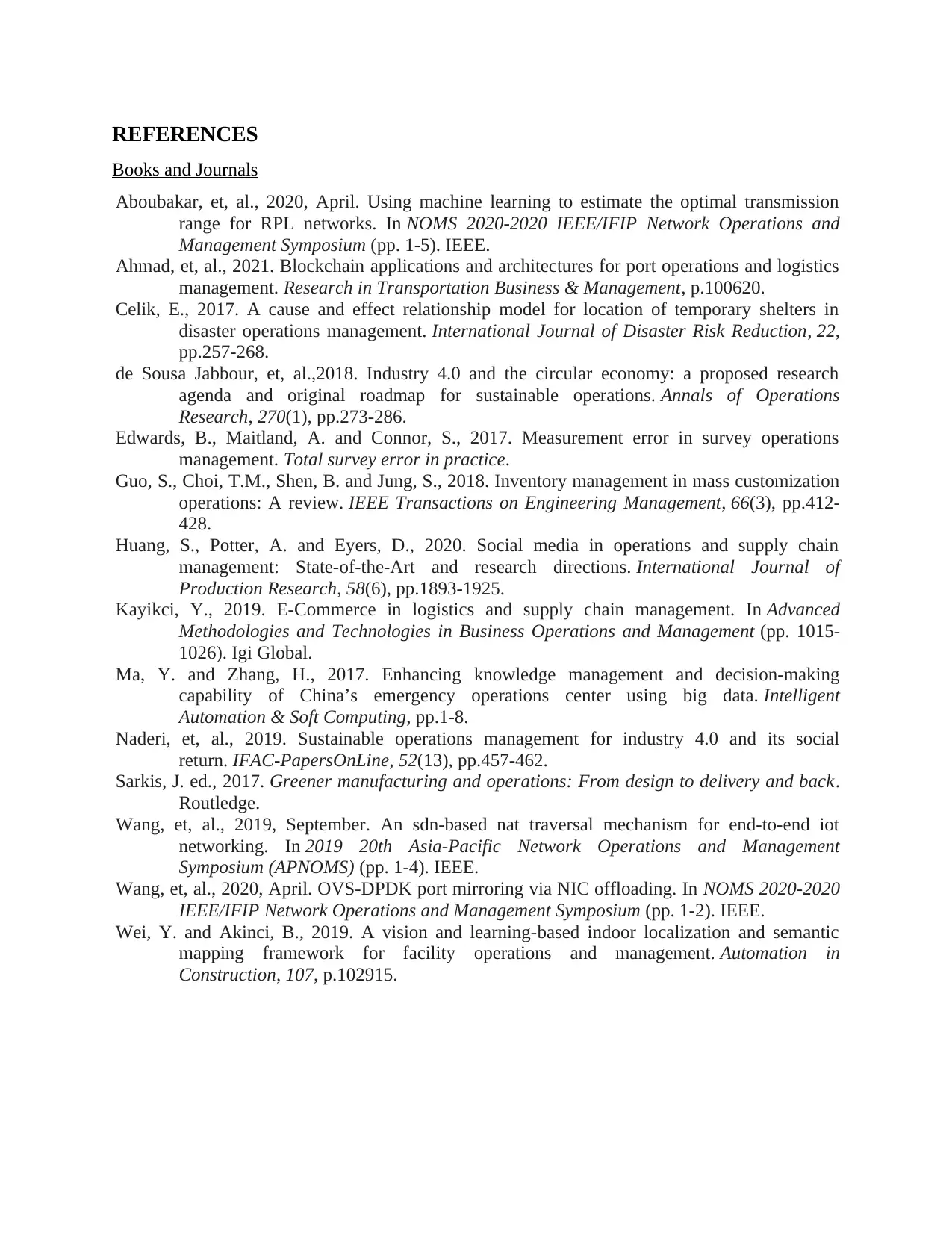
REFERENCES
Books and Journals
Aboubakar, et, al., 2020, April. Using machine learning to estimate the optimal transmission
range for RPL networks. In NOMS 2020-2020 IEEE/IFIP Network Operations and
Management Symposium (pp. 1-5). IEEE.
Ahmad, et, al., 2021. Blockchain applications and architectures for port operations and logistics
management. Research in Transportation Business & Management, p.100620.
Celik, E., 2017. A cause and effect relationship model for location of temporary shelters in
disaster operations management. International Journal of Disaster Risk Reduction, 22,
pp.257-268.
de Sousa Jabbour, et, al.,2018. Industry 4.0 and the circular economy: a proposed research
agenda and original roadmap for sustainable operations. Annals of Operations
Research, 270(1), pp.273-286.
Edwards, B., Maitland, A. and Connor, S., 2017. Measurement error in survey operations
management. Total survey error in practice.
Guo, S., Choi, T.M., Shen, B. and Jung, S., 2018. Inventory management in mass customization
operations: A review. IEEE Transactions on Engineering Management, 66(3), pp.412-
428.
Huang, S., Potter, A. and Eyers, D., 2020. Social media in operations and supply chain
management: State-of-the-Art and research directions. International Journal of
Production Research, 58(6), pp.1893-1925.
Kayikci, Y., 2019. E-Commerce in logistics and supply chain management. In Advanced
Methodologies and Technologies in Business Operations and Management (pp. 1015-
1026). Igi Global.
Ma, Y. and Zhang, H., 2017. Enhancing knowledge management and decision-making
capability of China’s emergency operations center using big data. Intelligent
Automation & Soft Computing, pp.1-8.
Naderi, et, al., 2019. Sustainable operations management for industry 4.0 and its social
return. IFAC-PapersOnLine, 52(13), pp.457-462.
Sarkis, J. ed., 2017. Greener manufacturing and operations: From design to delivery and back.
Routledge.
Wang, et, al., 2019, September. An sdn-based nat traversal mechanism for end-to-end iot
networking. In 2019 20th Asia-Pacific Network Operations and Management
Symposium (APNOMS) (pp. 1-4). IEEE.
Wang, et, al., 2020, April. OVS-DPDK port mirroring via NIC offloading. In NOMS 2020-2020
IEEE/IFIP Network Operations and Management Symposium (pp. 1-2). IEEE.
Wei, Y. and Akinci, B., 2019. A vision and learning-based indoor localization and semantic
mapping framework for facility operations and management. Automation in
Construction, 107, p.102915.
Books and Journals
Aboubakar, et, al., 2020, April. Using machine learning to estimate the optimal transmission
range for RPL networks. In NOMS 2020-2020 IEEE/IFIP Network Operations and
Management Symposium (pp. 1-5). IEEE.
Ahmad, et, al., 2021. Blockchain applications and architectures for port operations and logistics
management. Research in Transportation Business & Management, p.100620.
Celik, E., 2017. A cause and effect relationship model for location of temporary shelters in
disaster operations management. International Journal of Disaster Risk Reduction, 22,
pp.257-268.
de Sousa Jabbour, et, al.,2018. Industry 4.0 and the circular economy: a proposed research
agenda and original roadmap for sustainable operations. Annals of Operations
Research, 270(1), pp.273-286.
Edwards, B., Maitland, A. and Connor, S., 2017. Measurement error in survey operations
management. Total survey error in practice.
Guo, S., Choi, T.M., Shen, B. and Jung, S., 2018. Inventory management in mass customization
operations: A review. IEEE Transactions on Engineering Management, 66(3), pp.412-
428.
Huang, S., Potter, A. and Eyers, D., 2020. Social media in operations and supply chain
management: State-of-the-Art and research directions. International Journal of
Production Research, 58(6), pp.1893-1925.
Kayikci, Y., 2019. E-Commerce in logistics and supply chain management. In Advanced
Methodologies and Technologies in Business Operations and Management (pp. 1015-
1026). Igi Global.
Ma, Y. and Zhang, H., 2017. Enhancing knowledge management and decision-making
capability of China’s emergency operations center using big data. Intelligent
Automation & Soft Computing, pp.1-8.
Naderi, et, al., 2019. Sustainable operations management for industry 4.0 and its social
return. IFAC-PapersOnLine, 52(13), pp.457-462.
Sarkis, J. ed., 2017. Greener manufacturing and operations: From design to delivery and back.
Routledge.
Wang, et, al., 2019, September. An sdn-based nat traversal mechanism for end-to-end iot
networking. In 2019 20th Asia-Pacific Network Operations and Management
Symposium (APNOMS) (pp. 1-4). IEEE.
Wang, et, al., 2020, April. OVS-DPDK port mirroring via NIC offloading. In NOMS 2020-2020
IEEE/IFIP Network Operations and Management Symposium (pp. 1-2). IEEE.
Wei, Y. and Akinci, B., 2019. A vision and learning-based indoor localization and semantic
mapping framework for facility operations and management. Automation in
Construction, 107, p.102915.
⊘ This is a preview!⊘
Do you want full access?
Subscribe today to unlock all pages.

Trusted by 1+ million students worldwide
1 out of 12
Related Documents
Your All-in-One AI-Powered Toolkit for Academic Success.
+13062052269
info@desklib.com
Available 24*7 on WhatsApp / Email
![[object Object]](/_next/static/media/star-bottom.7253800d.svg)
Unlock your academic potential
Copyright © 2020–2025 A2Z Services. All Rights Reserved. Developed and managed by ZUCOL.





